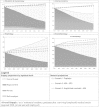Forecasting future needs and optimal allocation of medical residency positions: the Emilia-Romagna Region case study
- PMID: 25633752
- PMCID: PMC4328064
- DOI: 10.1186/1478-4491-13-7
Forecasting future needs and optimal allocation of medical residency positions: the Emilia-Romagna Region case study
Abstract
Objectives: Italian regional health authorities annually negotiate the number of residency grants to be financed by the National government and the number and mix of supplementary grants to be funded by the regional budget. This study provides regional decision-makers with a requirement model to forecast the future demand of specialists at the regional level.
Methods: We have developed a system dynamics (SD) model that projects the evolution of the supply of medical specialists and three demand scenarios across the planning horizon (2030). Demand scenarios account for different drivers: demography, service utilization rates (ambulatory care and hospital discharges) and hospital beds. Based on the SD outputs (occupational and training gaps), a mixed integer programming (MIP) model computes potentially effective assignments of medical specialization grants for each year of the projection.
Results: To simulate the allocation of grants, we have compared how regional and national grants can be managed in order to reduce future gaps with respect to current training patterns. The allocation of 25 supplementary grants per year does not appear as effective in reducing expected occupational gaps as the re-modulation of all regional training vacancies.
Figures
Similar articles
-
[A physician demand and supply forecast model for Nova Scotia].Cah Sociol Demogr Med. 2005 Apr-Sep;45(2-3):255-85. Cah Sociol Demogr Med. 2005. PMID: 16285405 French.
-
The impact of graduate medical education financing policies on pediatric residency training.Pediatrics. 1998 Apr;101(4 Pt 2):785-92; discussion 793-4. Pediatrics. 1998. PMID: 9544184
-
Are Time-Limited Grants Likely to Stimulate Sustained Growth in Primary Care Residency Training? A Study of the Primary Care Residency Expansion Program.Acad Med. 2015 Sep;90(9):1278-83. doi: 10.1097/ACM.0000000000000805. Acad Med. 2015. PMID: 26177524
-
[Residency in hygiene and preventive medicine: present and future].Epidemiol Prev. 2014 Nov-Dec;38(6 Suppl 2):110-4. Epidemiol Prev. 2014. PMID: 25759355 Review. Italian.
-
[Medical human resources planning in Europe: A literature review of the forecasting models].Rev Epidemiol Sante Publique. 2018 Feb;66(1):63-73. doi: 10.1016/j.respe.2017.10.001. Epub 2017 Dec 6. Rev Epidemiol Sante Publique. 2018. PMID: 29217324 Review. French.
Cited by
-
Forecasting the shortage of neurosurgeons in Iran using a system dynamics model approach.J Educ Health Promot. 2018 Jan 10;7:16. doi: 10.4103/jehp.jehp_35_16. eCollection 2018. J Educ Health Promot. 2018. PMID: 29417076 Free PMC article.
-
Application of a system dynamics model in forecasting the supply and age distribution of physicians.Croat Med J. 2020 Apr 30;61(2):100-106. doi: 10.3325/cmj.2020.61.100. Croat Med J. 2020. PMID: 32378376 Free PMC article.
-
A rapid review of the rate of attrition from the health workforce.Hum Resour Health. 2017 Mar 1;15(1):21. doi: 10.1186/s12960-017-0195-2. Hum Resour Health. 2017. PMID: 28249619 Free PMC article. Review.
-
Public Transportation Environment and Medical Choice for Chronic Disease: A Case Study of Gaoyou, China.Int J Environ Res Public Health. 2019 May 8;16(9):1612. doi: 10.3390/ijerph16091612. Int J Environ Res Public Health. 2019. PMID: 31071961 Free PMC article.
-
Future requirements for and supply of ophthalmologists for an aging population in Singapore.Hum Resour Health. 2015 Nov 17;13:86. doi: 10.1186/s12960-015-0085-4. Hum Resour Health. 2015. PMID: 26578002 Free PMC article.
References
-
- Nicholson S, Propper C. Chapter fourteen - Medical workforce. In: Pauly MV, Mcguire TG, Barros PP, editors. Handbook of health economics vol. 2. North-Holland: Elsevier; 2011. pp. 873–925.
-
- World Health Organization . The World Health Report 2006 - working together for health. Geneva: World Health Organization; 2006. - PubMed
-
- World Health Organization . Models and tools for health workforce planning and projections. Geneva: World Health Organization; 2010.
-
- Ono T, Lafortune G, Schoenstein M. Health workforce planning in OECD countries. OECD Health Working Papers. Paris: OECD; 2013.
-
- EU . Joint action health workforce planning and forecasting. 2013. - PubMed
MeSH terms
LinkOut - more resources
Full Text Sources
Other Literature Sources


